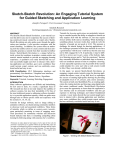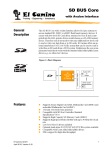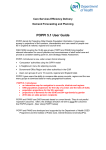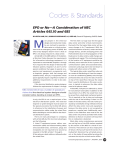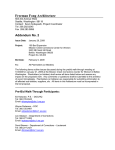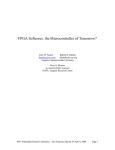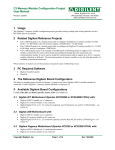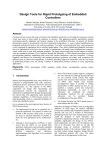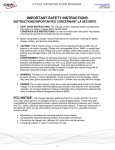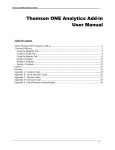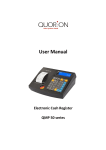Download Exoskeleton Control of a Programmable Robotic Arm
Transcript
EXOSKELETON CONTROL OF A PROGRAMMABLE ROBOT ARM USING FIELD-PROGRAMMABLE GATE ARRAYS Rhyan Andrade, Donnie Bañez, and Carlos Oppus Ateneo de Manila University [email protected], [email protected], [email protected] Abstract - The core objective of this project is the development of an exoskeleton controller for a prototype robotic arm, which is stand-alone, portable, programmable, and easy to maintain and use. The design and implementation utilizes a field-programmable gate array (FPGA) to meet this objective. At present, exoskeleton controllers of robotic manipulators are usually bulky, stationary and usually dependent on a personal computer or mainframe. The product of this project can become a basis for future exoskeleton controller designs, where it can make a significant impact on almost everyone especially in industry and research. Such designs will be invaluable in automated factory processes, construction, toxic waste handling such as maybe needed at the Philippine Nuclear Research Institute and hospitals handling radioactive materials, operations in a vacuum environment, honey-bee culturing and even deep sea or space exploration. Furthermore, the design can bring a complex technology to a level that everyone can comprehend, and can promise a full utilization of such. Based on existing designs and technologies studied, a lightweight, portable and easy-to-wear exoskeleton controller was constructed. This exoskeleton coupled with the use of an FPGA to serve as the system's main processor will make the controller of a robotic arm easier to move, handle, understand, use, and maintain. With the whole setup completed, the programmable robotic arm controlled by an exoskeleton controller is yet another important achievement in the field of robotics. 1. INTRODUCTION Robot control varies greatly in the manner it is implemented and the type of material it uses to drive the structures. There are three drive methods or techniques to cause movements in the joints of robots. These are the hydraulic drive, pneumatic drive and the electric drive. All three have their own advantages. For instance, hydraulic drive is preferred for high speed and heavy load requirements, but electric drive is the best choice for assembly operations that require precision and cleanliness. In today's industry settings, there are still a lot of hydraulic and pneumatic-driven robot technologies, but the electric-driven power systems tend to dominate and emerge above the other two mainly because of its easy maintenance, stability and flexibility[1]. Under the electric-driven systems, still a lot of methods are utilized. There are robotic manipulators controlled by entering directly the displacements of the end-effectors into the system from a computer's console[2]. These designs are used in high precision applications. There are also programmable systems wherein a series of movements are stored in a RAM to be played in a later time. Still there are designs whose controllers resemble human body parts and are used by wearing the controller and performing the actual movements the user wishes to implement in the robotic manipulators. These controllers are also referred to as exoskeleton controllers, because they resemble an exoskeleton harness worn by users to control the end effectors. 2. STATEMENT OF THE PROBLEM There are already many existing robot exoskeleton controllers. However most of these are dependent on a computer terminal or mainframe to operate. Although the computer is a powerful computational device, physically, a personal computer still takes too much space and is heavy to move from one location to another. This makes the robotic controllers attached to them inherit their properties of bulkiness and virtual immobility[3]. Moreover, such designs also require the users to first understand their programs to properly operate the system. A user may need an additional background on how to operate a computer and interface the controller with it. As such, a non-technical person may find it hard to understand how such a device may work. 2.1. Objectives To answer these problems and at the same time provide an advanced feature, the project aims to develop an exoskeleton control for a prototype robotic arm that is: 1) stand-alone, meaning it should be independent on any computer to perform its tasks; 2) portable, meaning it should be small and light enough to be carried anywhere and plugged into any power source; 3) programmable, meaning it should provide an option for the users to record a series of actions and be able to playback or perform the action repeatedly. This feature allows the transformation of the exoskeleton controller to a preprogrammed controller; and 4) user-friendly, meaning it should be comfortable enough to wear, easy to use, understand, and maintain. 2.2. Methodology The main hardware description language used to design the whole project was Verilog with Quartus and Verilogger Pro as the main software for editing, debugging and uploading. Before the actual code for the project was written, tests were run to check whether the input/output ports of the FPGA give the correct signals to the external circuits, and accept signals from the latter. Small Verilog codes corresponding to small circuits were written to check in isolation the external input and output ports of the FPGA. With the I/O ports properly configured and verified, the code for the main controller program was developed and tested for functionality through software simulation. The programming capability was added last, and subjected to the same simulation tests. Since all the hardware and software modules were already tested in isolation, the next step to be taken was to commission everything and test for functionality as a whole. The software was loaded into the FPGA and the external circuits were connected. Tests were conducted to verify the system's functionality as a whole and necessary observations were taken. 2.3. Significance of the Study The exoskeleton controller design would provide a blueprint for the design of a commercial robot arm controller to be used in practical day-to-day applications. The product of this project can become a basis for future exoskeleton controller designs, where it can make a significant impact on almost everyone especially in industry and research. Such designs will be invaluable in automated factory processes, construction, toxic waste handling such as maybe needed at the Philippine Nuclear Research Institute and hospitals handling radioactive materials, operations in a vacuum environment, honey-bee culturing and even deep sea or space exploration. These applications require the exposure of a person’s limb to a hazardous environment, thus increasing the risk involved in the operations. Using exoskeleton controllers to control robotic arms situated in the hazardous environments can decrease, and even eliminate the danger involved in the exposure. Furthermore, the design can bring a complex technology to a level that everyone can comprehend, and can promise a full utilization of such. Since motors driving a robot arm can have a torque greater than what a person can physically exert, portable robot arms can be carried anywhere by anyone and may be used as force amplifiers in doing heavy and loaded tasks such as lifting appliances off the floor, cleaning hard-to-reach places, handling hazardous materials, and a lot more. Moreover, due to the nature of exoskeleton control, the user does not have to compute for displacements to be entered into the system nor learn about a complicated software or hardware control program. He or she will only need to wear the controller and then simulate directly what they want the arm to do. Taking a step further, the programmable capabilities of the exoskeleton design would allow a lot of users to free themselves from routinary and patterned tasks and let the robot arm do the repetitive work. All that is needed is to program the sequence of tasks in the arm and then leave it to do the series of tasks on its own. user wearing the controller is doing, even with a few degrees of difference. The speed of the response of the robot arm to the movements of the exoskeleton controller also falls outside the project's scope. The robotic arm utilized in this project moves with a relatively slow speed (but its torque is considerable strong) and an attempt to increase its speed would either endanger the life of the DC motors or sacrifice the resolution and range of the control. What is important for this project is that the robotic manipulator follows the movements of the controller in its fullest range, even at the cost of maintaining the arm's natural speed. Another part of the project's limitation is the absence of a starting position for the robotic arm upon initialization. The design provided means of manually initializing the arm to a start position, either through using the exoskeleton controller itself or the manual controller. When the recording mode is switched on, the user can always manage to bring the robotic arm back to its original position after doing its task. So upon playback, the robot would still perform the same action in a cyclic manner. 3. HARDWARE The hardware mainly consists of five major parts: (1) the exoskeleton controller, (2) the sensor circuit, (3) the fieldprogrammable gate array or FPGA, (4) the arm controller relays, and (5) the robotic arm itself. In the normal mode of operation, the exoskeleton controller provides the input into the system by means of sensors located near the joints of the human arm. The input analog signals coming from these sensors are then fed into the sensor circuit to be converted into digital signals. Afterwards, the digital signals are entered into the FPGA. Based on the magnitude of the signals, the FPGA would send out the appropriate output signals to control the robotic arm. They would pass through the relays, which would either switch on or off the DC motors in the robotic arm trainer. The DC motors are the ones capable of moving the robotic arm in the system. Exoskeleton Controller ADC Sensor Circuit FPGA 2.4. Scope and Limitations The whole scope of the work deals with the interfacing of the sensors (50-KO potentiometers) from the exoskeleton controller to the robot arm, through a field programmable gate array. The main highlight would then be the external interface of the FPGA board to external circuits. Concerns on achieving an almost zero percent error between the exact angular displacement of the exoskeleton controller and that of the robot arm lies outside the project's scope. For the set goals of the project, it is enough for the robot arm to follow the general sense of what the Relay Circuit ROBOT ARM Figure 1. Block diagram of the entire hardware setup The exoskeleton controller serves as one of the input terminals of the system. It translates the motion of the human arm into a series of voltage signals that are in turn, interpreted by the field-programmable gate array (FPGA). After processing, the FPGA will send out the appropriate signals for the robotic arm to emulate. In this way, the robotic arm moves according to the motion of the exoskeleton controller. The exoskeleton controller is a device with six built-in potentiometers, serving as sensors, to detect the full motion of the human arm-as shown in Figure 4.1. Rotating the knob of the potentiometer (by the movement of the human arm), in effect, varies the resistance in the device. Thus, with a constant current driving the sensor, the voltage is also varied. By Ohm's Law, which is V = IR, the voltage would vary directly proportional to the change of resistance. These voltage signals are then fed into the sensor circuit. Shoulder Rais e The FPGA is a technology for making integrated circuits. What sets it apart from other chip technologies is that it is field programmable. One can design and implement any chip and would not need any external manufacturer. This entails less risk since one can afford to make a mistake and not lose several weeks just to have another chip made. In that case, just modify the design, re-program the chip, load it into memory, and run the system. 12-Bit Data Bus Exoskeleton Controller HC 245 12-Bit Bi-Directional Data Bus 3.1 Gripper MAXIM 198 ADC Elbow Raise Wrist Rotate LM 358 LM 358 LM 358 LM 358 LM 358 Shoulder Rotate Figure 2. The exoskeleton with the corresponding controls for the robotic arm Each of these potentiometers represents an axis of motion provided by the human joints. The entire human arm, from the shoulder to the hand, has four joints. There is a ball-and-socket configuration at the shoulder to accommodate the shoulder raise and shoulder rotate motion. The elbow joint provides the elbow bend. Wrist bend and wrist rotate are made by the wrist joint while the human hand provides the gripping motion. For the exoskeleton to imitate the human arm, there should be a sensor for each of axes of motion. 3.2. Sensor Circuit This circuit serves as the input interface between the exoskeleton controller and the FPGA. Designed to obtain readings from the five potentiometers attached to the exoskeleton, the sensor circuit mainly converts the analog input signals into digital signals. The MAX198 ADC chip makes this conversion possible. Other components within the circuit only serve to support this conversion. Furthermore, this circuit also enables the FPGA to communicate with the ADC and vice versa. 3.3. Field-Programmable Gate Array SENSORS Figure 3. Block diagram depicting the various connections inside the sensor circuit Since it defines the nature of the project, the FPGA has become the heart and brain of the system. Inputs are read from the sensors and are then converted but they must pass through the FPGA for processing. All other circuits serve as wired peripherals for proper communication and translation of signals from the exoskeleton controller to the FPGA and then to the robotic arm. Based on the inputs, the code within the FPGA will determine the appropriate response for the robotic arm to do. It is the one that decides which motors of the robotic arm should run and for how long. The FPGA can also be configured to implement different modes of operation. Because of it, the system can also be made programmable, meaning the user can record a series of actions through the exoskeleton and the robotic arm can do it repetitively and indefinitely. Finally, the FPGA is the reason for making the system portable and independent from a computer. It no longer needs an external processor to decode the signals; the instructions are already encoded within the miniature programmable integrated circuit[4]. 3.4. Relay Circuit In contrast with the sensor circuit, the relay circuit serve as the output interface between the FPGA and the robotic arm. After decoding the inputs and determining the proper response, the FPGA will now send signals to activate certain relays, which act as switches for the DC motors within the robotic arm. To switch on a motor to move to a particular direction, the FPGA needs only to send logic high to its corresponding output port. There are ten (10) motors controlled by the FPGA, two for each of the motors of the robot arm. Each motor is controlled by a single bit from the FPGA through its port P2. This single bit is connected to the input of an opto-isolator network (made up of 4N25 optoisolator, 2N3907 transistor and several resistors to protect the FPGA from feedback signals coming from the output), which is in turn connected to the transistor driver circuit at the other end. The driver circuit (made up of 2n2222 transistor and several transistors) turns on an electromechanical relay which eventually switches a particular motor in the robot arm. This opto-isolator and driver circuit network is constructed for each of the ten motors. As an alternative input device, the manual controller that came along with the robot arm (its original controller) was also interfaced with the relay circuit. It shares the 10-bit wide data bus output of the relay circuit connected to the robot arm. If the exoskeleton controller is disabled, the robot arm can still be controlled by the manual controller because the input data bus to the robot arm is always connected to the manual controller. Manual Controller FPGA OptoIsolator Circuit Relay ROBOT ARM is the motor index which serves as an indicator of the appropriate motor or joint that the valid data converted by the ADC is associated with. For instance, a motor index of zero pertains to the gripper and thus the ADC will convert the data coming in from the potentiometer of the gripper and a corresponding output will be sent to the motors controlling the gripper of the robot arm. Once a 12-bit valid data is ready at the output terminal of the ADC, the program enters the Data Storing/Loading block and stores this data into a special register inside the FPGA along with a stamp of the particular joint the valid data is associated with. The manner in which the data is stored depends on the input signals fed into the Data storing block by the input block of the program. The Input block comprises of a small circuitry that provides the users four input buttons, one for each of the three modes (normal, recording and playback) and another as a master reset button. All buttons, equipped with edge-detectors and debouncer units, serve as the user’s terminal for switching between modes of operation. In the normal and recording modes of operation, valid data is taken from the output of the ADC and the motor index used is the one sent by the FPGA to the ADC in the control word. However, in the recording mode, the valid data and its corresponding motor index are also simultaneously stored in the RAM to be used later in the playback mode. In playback mode, valid data and motor index are not taken form the ADC and the control word, but instead, they are read from the RAM of the device, the contents of which are pre-recorded earlier in recording mode. After proper reading and storing of valid data and motor index, the program enters the Data Processing and Output block. In this block, the valid data is compared to a value stored in a base register inside the FPGA. For every axis of motion, there is a corresponding base register to be used form comparison, and the motor index is the one responsible for choosing the right base register to be used for a particular valid data. For instance, for a motor index of zero, the valid data is compared to reg1, a base register corresponding to the gripper. Start Figure 4. Block diagram of the relay circuit E. Robotic Arm The project used the commercially-available Robotic Arm Trainer (OWI-007) as its mechanized output. It is mainly a demonstration device that teaches the basic robotic sensing and locomotion principles while testing one’s motor skill as the user controls the arm. It has five degrees of freedom that the project can utilize to perform various human arm movements. The device also has a manual controller although the setup had a few significant modifications regarding the robotic arm’s input and power supply. 4. SOFTWARE The hardware description language used in this project is Verilog HDL, because it is sufficient enough to meet the set objectives, and at the same time easier and simpler to write and understand. The whole process starts with the FPGA sending the appropriate control signals to the ADC chip, along with the control word which instructs the ADC to convert analog input from a particular channel. An important part of this control word ADC Communication No Data Ready ? Yes Data Storing/Loading Inpu t Data Processing and Output Display from one mode to the other and it comes with a very comprehensive User’s Manual. Further, the exoskeleton controller is easy to wear and use. It wraps around the arm and chest very comfortably and is made adjustable to fit all types of body proportions. Figure 5. Flow Chart of the Main HDL Program The valid data is compared against the base register if it is less than, greater than or equal to the base value within some margin. If the value is equal or still within the set margin, the program does nothing and loops back for another input. If the value is less than or greater than, an appropriate signal is sent out by the FPGA to the external motor controller which turns on a particular motor in the robot arm. After which, the value of the base register is then assigned the value of the recent valid data, and thus the valid data value becomes the next basis fro the next input. The margin can be adjusted to vary the sensitivity of the robot arm to the exoskeleton controller’s movements, a high value means less sensitivity to the movements but also less prone to noise responses, and a low value means high sensitivity to movements but a higher chance of responding to noise fluctuations in the input. Optimal performance is obtained by adjusting the margins to balance off the response to the controller and to signal noise. The last block that the program enters into is the Display bock, which serves as the window of the FPGA to the users. It displays useful information about the current mode of operation, the status of the interface between the controller, FPGA and the relay circuit, and a memory usage indicator. 5. CONCLUSION The whole system was reviewed and analyzed based on the project objectives. In general, all the objectives of the project were met with high standards: a) Stand-Alone Property The whole setup does not need a computer to fulfill its function. As a single independent unit, the exoskeleton controller can manipulate the robot arm very well. The FPGA serves as the main CPU of the whole system, thus eliminating the need to be attached to any other processor. The system’s power supply is built-in, and can be plugged into any local AC outlet. b) Portability The controller, the robot arm and the System Control Unit (SCU) which is comprised by the FPGA, the sensor circuit, the relay circuit, and the power supplies are all readily transferable from one location to the other. The main SCU is packaged as a single box and can be plugged into any available 220V AC socket. All three devices, the arm, the controller and the SCU are light enough for anyone to carry. c) Programmability The project allows a maximum of five (5) minutes recording time or 8192 valid_data entries to record a series of movements. The system provides a very stable recording and playback capabilities. However the playback is still origin dependent. d) User-friendliness The whole setup’s user interface is very simple. It only involves four (4) input buttons to switch All the set objectives for this project were given sound solutions by the project. Though there may be some limitations to the design, these are small enough to affect the overall desired performance of the system. Moreover, the whole project does not involve high accuracy movement translations nor any study on the speed of response of the robot arm. REFERENCE [1] R. J. Shilling, “Fundamentals of Robotics: Analysis & Control”. New Jersey: Prentice Hall Inc., 1990. [2] D.G. Caldwell, O. Koeak and U. Andersen, "Multi-armed dexterous manipulator operation using glove/exoskeleton control and sensory feedback," International Conference on Intelligent Robots and Systems, vol. 2. Pittsburgh, Pennsylvania, USA. [3] J. A. Rehg. “Introduction to Robotics: A Systems Approach“. New Jersey, Prentice Hall Inc., 1985. [4] “Digilab 20Kx240 Manual,” English Ed., Ver. 1.1. Sasco Semiconductor, 2000.





